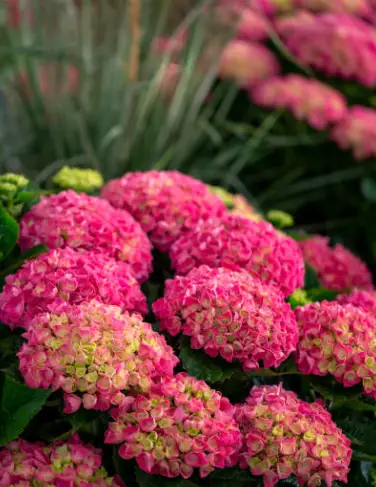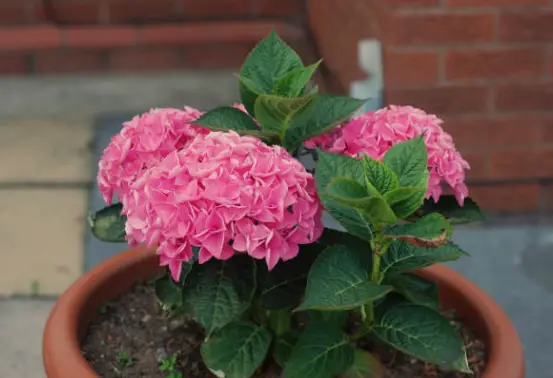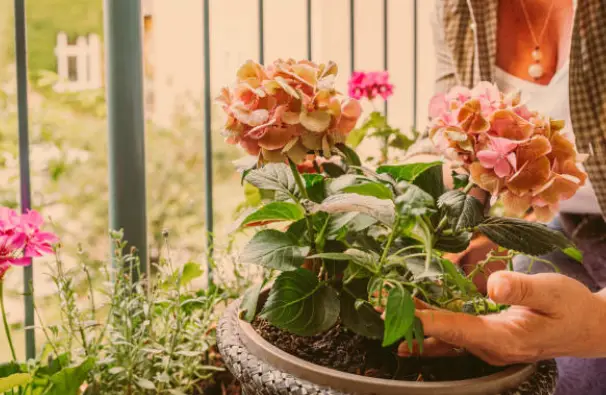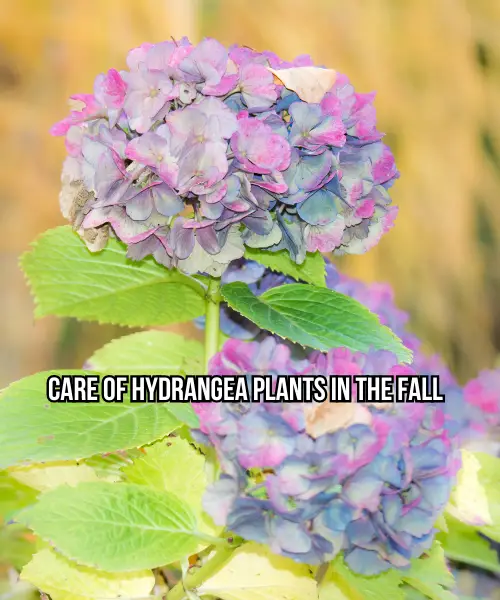As the cooler temperatures of fall arrive, many flowering plants are fading and preparing for their winter dormancy.
Not hydrangeas, though these fabulous flowering shrubs put on a spectacular show in autumn that is truly something to behold.
With careful fall care and preparation, you can ensure your hydrangeas look their best next year and for years to come.
The Beauty of Fall Hydrangeas
Hydrangeas are cherished for their big, bold blooms that add splashes of vibrant color to the landscape for months on end during the spring and summer.
But even after that impressive flowering display, hydrangeas keep on giving with some incredible fall color as the seasons change.

Hydrangea Plants
The fall hydrangea show starts in late summer/early fall when the faded flowers take on new hues.
Depending on the variety, the blooms may transition from their earlier colors to rich pinks, deep purples, antique greens, or multi-colored tie-dye effects.
Many varieties develop red, burgundy or bronze colors as well.
But it’s not just the blooms putting on a show; the foliage of hydrangeas also changes to beautiful shades of yellow, orange, red, purple, or combinations of those warm tones in fall too.
With both the fading flowers and leaves transitioning to spectacular autumn colors, hydrangeas become a true showstopper in the fall garden.
Of course, the fall display varies a bit depending on the hydrangea variety. Some of the most stunning fall bloomers include:
Bigleaf Hydrangeas (H. macrophylla)
- Varieties like ‘Endless Summer,’ ‘Blushing Bride’ and lace caps showcase incredible reds, purples and combinations
Oakleaf Hydrangeas (H. quercifolia) - Large, lobed leaves become deep red, orange, or purple-red in fall
Panicle Hydrangeas (H. paniculata) - Cultivars like ‘Limelight’ and ‘Fire Light’ develop red, pink or burgundy tones
Smooth Hydrangeas (H. arborescens) - ‘Annabelle’ and ‘Incrediball’ blooms fade to green shades in fall
No matter which hydrangea variety you’re growing, they all put on a dazzling fall display when properly cared for as the season transitions.
Essential Fall Hydrangea Care

Care of Hydrangea Plants in the Fall
While hydrangeas are stunning in fall, they do require some extra care and preparation to look their best and survive cold winter conditions.
Follow these fall care tips for healthy, vibrant hydrangeas:
Pruning And Deadheading
Once hydrangea blooms have faded and begun changing color in fall, you can remove the spent flower heads.
This redirects the plant’s energy into developing robust stems, branches and roots for the upcoming winter.
For smooth (arborescens) and panicle (paniculata) hydrangeas, you can trim back any stray or scraggly branches as well to keep the shrub’s shape neat and tidy.
Do not cut back oakleaf (quercifolia) hydrangeas in fall, though.
This variety blooms on old wood so hard pruning now will remove the buds that would produce next year’s blooms.
Wait until late winter or early spring before new growth emerges to prune oakleaf hydrangea.
For bigleaf (macrophylla) hydrangeas, don’t prune at all in fall.
These varieties bloom on old wood as well. Remove only the spent flowers but leave the stems intact for now.
Fertilizing
Fall is the ideal time for the last fertilizer application of the season for hydrangeas.
Use a balanced fertilizer or one higher in phosphorus to encourage robust root development, which helps the plants survive winter.
Stop fertilizing about 6 weeks before your first expected frost.
Watering
Don’t let hydrangeas dry out in the fall; continue providing about 1 inch of water per week until the ground freezes. The roots need that moisture to stay hydrated through winter’s cold, dry conditions.
Mulching
Apply a 2-3-inch layer of shredded bark, pine needles, or leaves around the base of hydrangeas in late fall.
This insulating mulch blanket protects the roots and crowns from frigid winter temperatures. It also helps retain the soil moisture that the plants drink up on warmer winter days.
Protection
Hydrangeas are generally cold-hardy in zones 5–9, but extra protection can help them pull through tough winters while keeping the blooms prettier too.
For buddleia, oakleaf, mountain, and climbing hydrangeas, no extra protection is needed. They’re extremely hardy and will go dormant on their own over winter.
For smooth hydrangeas, pile extra mulch or leaves around the base and cover with burlap. You can also build a cage around the plant and stuff it with straw or leaves.
Bigleaf and panicle hydrangeas need protection from cold, drying winds and extreme cold snaps.
You can build a cage like for the smooth hydrangeas by wrapping the stems in burlap and filling the cage with insulating mulch.
Or make teepee structures over shrubs using stakes and burlap.
Fall Planting and Transplanting

If you want to add new hydrangeas to the landscape or move existing ones, fall is the ideal time to plant or transplant.
The cool temperatures and warm soil allow plants to establish healthy root systems without the summer heat stress.
Plant hydrangeas in a spot with well-drained soil and the appropriate amount of sun exposure for the variety.
With this essential fall care, your hydrangeas will thrive through winter’s cold and re-emerge with vigor in spring, ready to kick off another lush season of beautiful blooms.
Preserving Fall Hydrangea Blooms
One of the best parts about fall hydrangea flowers is being able to preserve them to enjoy indoors even after the flowering season has ended.
Dried hydrangea blooms make gorgeous, long-lasting displays when properly preserved.

Here’s how to dry hydrangea blooms for arrangements and crafts:
Harvest blooms when they reach the desired color stage, ideally after nighttime temperatures have dipped into the 60s. Cut stems with 6–12 inches of stem attached in the morning.
Remove any leaves from the cut stems and hang upside down in a warm, dry location with good airflow for 2-4 weeks until the petals feel papery.
Basements, attics, or utility rooms work well. You can hang small bunches from racks or tie the stems with twine and hang the whole bunch.
Once fully dried, spray or dip the preserved hydrangea blooms in an acrylic finish spray to lock in color and protect the flowers.
Display dried hydrangeas in vases or craft them into gorgeous wreaths, swags, bouquets, and more for beautiful seasonal decor inside the home.
Don’t toss those dried blooms after the holidays either. Soak them in water mixed with a floral preservative like Crowning Glory for 2-3 hours to rehydrate. The petals plump back up beautifully!
With their incredible shades of burgundy, purple, red, pink, and more, hydrangeas are one of autumn’s most glorious flowering plants.
Give them some simple fall TLC, and these beloved landscape shrubs will surge into winter in prime condition.
Vibrant fall hydrangea color and lush growth await next spring when these garden MVPs burst back onto the floral scene!
Here’s more on fall hydrangea care and enjoying the blooms
Overwintering Potted Hydrangeas

If you’re growing hydrangeas in containers, they’ll need some extra protection to survive winter’s harsh conditions. Follow these steps to overwinter potted hydrangeas successfully:
1. Stop fertilizing about 6 weeks before your first expected frost. This allows the plant to begin hardening off for winter dormancy.
2. Keep watering regularly until the ground freezes to ensure the soil doesn’t dry out completely. Hydrated soil better insulates roots from extreme cold.
3. Before hard freezes arrive, move potted plants to a sheltered location, like a garage or basement, where temperatures stay above freezing. An unheated sunroom can work too if it doesn’t get below 20°F.
4. Increase humidity around plants by misting the leaves periodically or setting pots on trays of pebbles filled with water. Dry air can desiccate stems and buds.
5. If sheltering indoors isn’t possible, move pots together and pile insulating mulch like bark chips, leaves, or straw around the pots to the rim.
6. Wrap outside pots in burlap and tar paper to protect roots and stems from harsh winter conditions.
7. Apply an antidesiccant spray like Wilt-Pruf to prevent damaging moisture loss from the stems and buds over winter.
Hydrangeas in Warm Winter Climates
In zones 8–10, where winter temperatures remain very mild, hydrangeas don’t need elaborate protection like in colder zones.
However, some basic care helps them look their best in winter.
- Apply a 2-3-inch layer of mulch to insulate the soil and retain moisture as temperatures fluctuate.
- Water deeply during dry spells to keep the soil moist but not saturated.
- Fertilize in late winter with a balanced fertilizer to promote fresh growth.
- Prune dead or damaged stems in very late winter before spring buds break.
Winter Hydrangea Displays
Hydrangea blooms offer prime materials for festive holiday decorations and winter displays both inside and out.
Here are some fun ways to enjoy hydrangea blooms through winter:
Holiday Wreaths and Swags
Dried hydrangea blooms add gorgeous color and texture, woven into grapevine wreaths and swags for doors and entryways.
They look beautiful mixed with evergreens, pinecones, seed pods, and ribbons.
Centerpieces and Mantels
Fill bowls and vases with dried hydrangea blooms as tabletop centerpieces or place them along mantels mixed with candles and greenery for holiday flair.
Winter Bouquets
Make long-lasting dried bouquets combining hydrangeas with stem-preserved wildflowers, seedpods, grasses, and interesting twigs to display all winter.
Outdoor Arrangements
For a pop of winter color outside, create dried flower arrangements or wreaths using hydrangea blooms along with evergreen boughs, seedpods and natural accents like curly willow stems.
Secure in containers and set on porches or hang from trees.
Hydrangeas are truly the gift that keeps on giving throughout fall and winter!
With these tips, you can appreciate every last bloom from your hydrangea shrubs even after frost arrives.
Simple fall preparation ensures they’ll emerge from dormancy in spring, ready to dazzle again with an all-new show.




